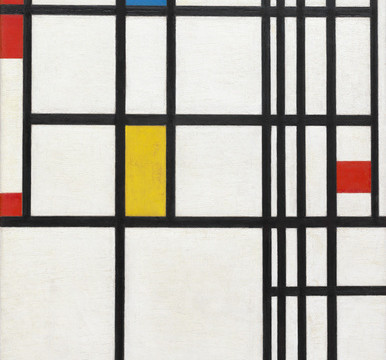
“Because it means so much to me…”
Contemplating the Mondrians at the Museum of Modern Art in New York City earlier this month, I overheard a woman exclaim, “I really wish I understood what this artist was trying to express in these paintings! I wish someone could explain it to me!” She was carefully studying Mondrian’s radically simplified form and palette: horizontal and vertical black lines bordering color blocks of red, yellow, blue, white, and grey. Her statement of frustration reminded me of a line from Mondrian’s essay “Dialogue on the New Plastic,” published in the De Stijl journal in 1919. In this essay, a hypothetical viewer, described as “a Singer” questions “a Painter,” Mondrian’s alter-ego. Through this device, Mondrian presupposes a confused, even hostile, viewer and anticipates many of the questions he/she might pose. Mondrian calmly and thoughtfully answers them.
When this woman at MoMA expressed her confusion over these De Stijl paintings, she was unknowingly paraphrasing Mondrian’s hypothetical viewer, the Singer, whose opening lines from nearly one hundred years ago were these: “I admire your earlier work. Because it means so much to me, I would like better to understand your present way of painting. I see nothing in these rectangles. What are you aiming at?” As an art historian who specializes in avant-garde art, I felt compelled to come to the woman’s aid. I began by explaining that Mondrian was fiercely serious about his project. Even though the paintings look very simple, he labored over each of them for months. What he was trying to express was “the immutable” through relationships between color-blocks, held together in a kind of quivering harmony with black horizontal and vertical lines. I told her that, as with all abstract works, the viewer is meant to contemplate these artworks for long periods of time, rather than to shift past them, one by one, as most of us do.
I suggested an exercise that I often had my students perform in class. Before one of the Mondrians that was on view at MoMA, Composition in Red, Blue, and Yellow (1937-42), I asked her to hold up her hand to visually “block out” the small blue rectangle in the lower right corner. “What just happened to the painting?” I asked. “It becomes top-heavy,” she observed. In this work, the upper half of the composition is busy with lots of black lines and several small color-blocks. The only color-block in the lower half of the composition is a little blue one in the lower right corner, but it holds tremendous power, drawing our attention to that corner and essentially anchoring the entire composition. The color-blocks are held together in a state of harmony that is simultaneously a state of tension, always on the verge of breaking up.
At this point, I had been talking for a long time and my daughter, who had accompanied me to the museum, had long ago wandered away, overwhelmed by embarrassment of her fanatical art historian mother. But the woman who got the impromptu art history lesson at MoMA was appreciative and vowed to find some books on avant-garde art and continue her journey.